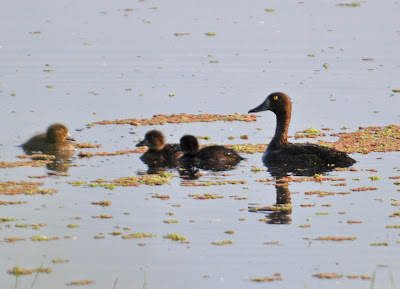 |
| Juvenile Common Tern (c) T.S. |
 |
| Juvenile Robin |
 |
| Whitethroat |
 |
| One of many juv. Chaffinches |
 |
| Acrobatic juv. Blue Tit |
 |
| Sedge Warbler all above pics (c) Bark |
Despite dire warnings of torrential downpours, both mornings were warm and
mostly sunny. In the sunshine there was plenty to see especially invertebrate
life.
On the bird front there are now quite extensive mixed flocks feeding in
the hedgerows and on the ground. It is interesting to see that the insectivorous
species group together and the buntings and finches likewise.
Clearly it is
to do with food sources, diets and preferences. There were very large numbers of
immature
Chaffinches mixed in with fewer
Linnets and
Reed Buntings.
Bullfinches
could also be found in Moorleys (the proper name for the car park field) but
tended to keep themselves to themselves. The path through Moorleys is now open
again and offers a pleasant alternative to the track alongside the
Closes.
The
Common Tern chick is now flying, but not yet hunting for itself.
There are still three adult birds present and all three took part in the raising
of the chick. Might the third bird be a previous years offspring? I don't know
if this is a regular strategy for
Common Terns. The tern raft took much time and
trouble from the reserve staff to build and to site, it is very gratifying to
see that their efforts have been so worthwhile.
The
Marsh Harrier continues
to haunt the northern edge of Greenaways and the MOD land, it seldom seems to
venture over the reedbed, at least not when I am there.
Several waders were
around including
Green Sandpipers and on Sunday morning four
Black-tailed
Godwits, that flew over and landed somewhere out on Greenaways. Out from the
first screen the azolla weed was much clearer than last weekend and there were
larger numbers of eclipse ducks to be seen out on the water. They included
Pochard, Shoveller, Gadwall, Teal and a preponderance of
Mallard. The
Bearded
Tits were heard pinging out in the reedbed and we had a brief glimpse of two
birds in flight over the reeds on Saturday morning.
The highlight of the
weekend out by the first screen was the success of the “reptile city”. There
were at least eight
Common Lizards to be seen, basking on the tussocks of dry
grass and the logs. Some of them were very small and dark others clearly much
larger, but probably still not fully adult. Congratulations to Joe Harris the
warden for constructing such an effective piece of habitat.
On Saturday
morning we walked up around the edge of Ashgrave on the public footpath between
Ashgrave and the wood. At times there were clouds of butterflies coming up from
the grass and from the bramble flowers. It was possible to imagine what the
countryside in summer might have been like in times before intensive agriculture
and heavy pesticide use. They were mostly
Meadow Browns,
Ringlets and
Gatekeepers, but amongst them were also
Marbled Whites,
Green-veined Whites,
Brimstones,
Skippers and the odd
Peacock. There were also at least five
Silver-washed Fritillaries that had ventured out of the woodland to nectar on
the brambles along the path. The warm settled weather seems to have benefitted
Butterflies after the last two cold and wet summers, it remains to be seen if
the
Brown Hairstreaks will stage similar resurgence, they should be on the wing
in a few weeks time.
Reptile, Amphibian and Invertebrate Supplement
 |
| Common Lizards |
 |
| Great Crested Newt |
 |
| Essex Skipper ? |
 |
| Peacock |
 |
| Emperor Dragonfly |
 |
| Silver washed Fritillary on Ashgrave |
 |
| Brimstone (c) all above pics Bark |


























